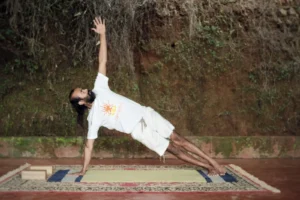Table of Contents
ToggleVasisthasana: Powerful Arm and Wrist Strengthener
The side plank pose, or Vasisthasana, perfectly balances power and flexibility. It strengthens muscles, improves balance, and stretches the body. This pose opens the heart chakra and calms the nervous system. Most power, vinyasa, and sculpt yoga classes include this pose.
This foundational pose, often used in Ashtanga sequences, helps transition to advanced postures. It energizes the Solar Plexus (Manipura Chakra) and strengthens the musculoskeletal system. Vasisthasana builds endurance and concentration, preparing students for challenging variations like Visvamitrasana or Kapinjalasana (Partridge Pose).
Steps for Side Plank Pose
-
Start in Adho Mukha Svanasana (Downward-Facing Dog Pose).
-
Hold for 4–6 breaths, extending your hamstrings, arms, and shoulders.
-
Move into Phalakasana (Plank Pose), aligning hips with shoulders and chest.
-
Turn shoulders and hips to the left, forming a 90-degree angle, and lift the left arm.
-
Stack the left foot over the right foot, engage your core, and hold for four breaths.
-
Exhale and lower the arm, returning to Adho Mukha Svanasana.
-
Rest for four breaths, then repeat on the opposite side.
Focus on keeping both sides evenly stretched. Beginners may notice leg and hip shaking; practice will stabilize the pose.
Benefits of Side Plank Pose
Lengthening and Strengthening
Vasisthasana stretches arms, shoulders, chest, abdomen, back legs, calves, and ankles. The bottom leg’s inner obliques stretch, while the top leg’s external obliques strengthen. Supporting body weight with one arm builds strength in wrists, shoulders, abs, and core.
The pose also teaches scapula engagement, core stability, and spine alignment. Muscles including biceps, triceps, glutes, hamstrings, quadriceps, and calves activate to maintain balance.
Flexibility and Joint Mobility
Vasisthasana improves flexibility and range of motion in the knees, ankles, hips, shoulders, and wrists.
Chest Expansion and Breath Awareness
The pose opens the chest and engages the diaphragm, encouraging thoracic breathing and improving oxygen flow.
Awareness and Concentration
Maintaining spinal alignment trains body intelligence and improves focus. Students build stamina and mental clarity for more advanced poses.
Alignment and Posture
Vasisthasana positions the body in a long, diagonal line from head to heels. Core engagement ensures proper alignment, supports the spine, and improves Prana flow while reducing the risk of injury.
Energizing and Relaxing
The pose energizes the body, stimulates internal organs, and enhances digestion (Jatharagni). Regular practice strengthens the heart and circulatory system.
Emotional Balance
Balancing in Vasisthasana builds mental fortitude and confidence. Chest openers release stored emotions, including rage, grief, and sadness, while stimulating the Solar Plexus Chakra.
Who Should Practice with Caution
-
Students recovering from wrist, elbow, shoulder, neck, hip, back, knee, or ankle injuries should avoid this pose.
-
Individuals who recently had abdominal surgery must consult an instructor before attempting Vasisthasana.
-
Beginners lacking core strength should use wall support for safety.
-
Seniors, pregnant women (first trimester), or those with migraines, high blood pressure, vertigo, carpal tunnel, or herniated discs should refrain.
Students must maintain body-breath awareness to prevent strain. Proper hip and core stability is essential for safely entering and exiting the posture.





